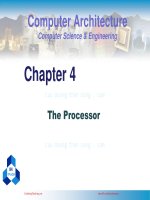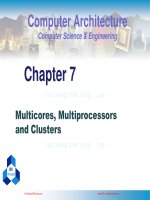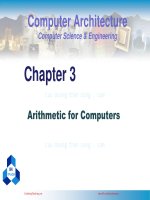kiến trúc máy tính nguyễn thanh sơn l3 probabilistic learning sinhvienzone com
Bạn đang xem bản rút gọn của tài liệu. Xem và tải ngay bản đầy đủ của tài liệu tại đây (692.47 KB, 32 trang )
Machine Learning and
Data Mining
(IT4242E)
Quang Nhat NGUYEN
Hanoi University of Science and Technology
School of Information and Communication Technology
Academic year 2018-2019
CuuDuongThanCong.com
/>
The course’s content:
◼
Introduction
◼
Performance evaluation of the ML and DM system
◼
Probabilistic learning
◼
Supervised learning
◼
Unsupervised learning
◼
Association rule mining
Machine learning and Data mining
CuuDuongThanCong.com
/>
2
Probabilistic learning
◼
Statistical approaches for the classification problem
◼
Classification is done based on a statistical model
◼
Classification is done based on the probabilities of the
possible class labels
◼
Main topics:
• Introduction of statistics
• Bayes theorem
• Maximum a posteriori
• Maximum likelihood estimation
• Naïve Bayes classification
Machine Learning and Data Mining
CuuDuongThanCong.com
/>
3
Basic probability concepts
◼
Suppose we have an experiment (e.g., a dice roll) whose
outcome depends on chance
◼
Sample space S. A set of all possible outcomes
E.g., S= {1,2,3,4,5,6} for a dice roll
◼
Event E. A subset of the sample space
E.g., E= {1}: the result of the roll is one
E.g., E= {1,3,5}: the result of the roll is an odd number
◼
Event space W. The possible worlds the outcome can occur
E.g., W includes all dice rolls
◼
Random variable A. A random variable represents an
event, and there is some degree of chance (probability)
that the event occurs
Machine Learning and Data Mining
CuuDuongThanCong.com
/>
4
Visualizing probability
P(A): “the fraction of possible worlds in which A is true”
Event space of all
possible worlds
Worlds in which
A is true
Its area is 1
Worlds in which A is false
[ />Machine Learning and Data Mining
CuuDuongThanCong.com
/>
5
Boolean random variables
◼
A Boolean random variable can take either of the two
Boolean values, true or false
◼
The axioms
• 0 P(A) 1
• P(true)= 1
• P(false)= 0
• P(A V B)= P(A) + P(B) - P(A B)
◼
The corollaries
• P(not A) P(~A)= 1 - P(A)
• P(A)= P(A B) + P(A ~B)
Machine Learning and Data Mining
CuuDuongThanCong.com
/>
6
Multi-valued random variables
A multi-valued random variable can take a value from a set
of k (>2) values {v1,v2,…,vk}
P( A = vi A = v j ) = 0 if i j
P(A=v1 V A=v2 V ... V A=vk) = 1
i
P( A = v1 A = v2 ... A = vi ) = P( A = v j )
k
P( A = v ) = 1
j =1
j =1
j
i
P(B A = v1 A = v2 ... A = vi ) = P( B A = v j )
[ />
j =1
Machine Learning and Data Mining
CuuDuongThanCong.com
/>
7
Conditional probability (1)
◼
P(A|B) is the fraction of worlds in which A is true given
that B is true
◼
Example
• A: I will go to the football match tomorrow
•B: It will be not raining tomorrow
• P(A|B): The probability that I will go to the football
match if (given that) it will be not raining tomorrow
Machine Learning and Data Mining
CuuDuongThanCong.com
/>
8
Conditional probability (2)
Definition:
P( A | B) =
P ( A, B )
P( B)
Corollaries:
P(A,B)=P(A|B).P(B)
Worlds
in
which B
is true
P(A|B)+P(~A|B)=1
k
P( A = v | B) = 1
i =1
Worlds in which A
is true
i
Machine Learning and Data Mining
CuuDuongThanCong.com
/>
9
Independent variables (1)
◼
Two events A and B are statistically independent if the
probability of A is the same value
• when B occurs, or
• when B does not occur, or
• when nothing is known about the occurrence of B
◼
Example
•A: I will play a football match tomorrow
•B: Bob will play the football match
•P(A|B) = P(A)
→ “Whether Bob will play the football match tomorrow does not
influence my decision of going to the football match.”
Machine Learning and Data Mining
CuuDuongThanCong.com
/>
10
Independent variables (2)
From the definition of independent variables P(A|B)=P(A),
we can derive the following rules
• P(~A|B) = P(~A)
• P(B|A) = P(B)
• P(A,B) = P(A). P(B)
• P(~A,B) = P(~A). P(B)
• P(A,~B) = P(A). P(~B)
• P(~A,~B) = P(~A). P(~B)
Machine Learning and Data Mining
CuuDuongThanCong.com
/>
11
Conditional probability for >2 variables
◼
◼
P(A|B,C) is the probability of A given B
and C
B
C
Example
•
•
•
•
A: I will walk along the river tomorrow
morning
A
B: The weather is beautiful tomorrow
morning
P(A|B,C)
C: I will get up early tomorrow morning
P(A|B,C): The probability that I will walk
along the river tomorrow morning if (given
that) the weather is nice and I get up early
Machine Learning and Data Mining
CuuDuongThanCong.com
/>
12
Conditional independence
◼
Two variables A and C are conditionally independent
given variable B if the probability of A given B is the same
as the probability of A given B and C
◼
Formal definition: P(A|B,C) = P(A|B)
◼
Example
• A: I will play the football match tomorrow
• B: The football match will take place indoor
• C: It will be not raining tomorrow
• P(A|B,C)=P(A|B)
→ Given knowing that the match will take place indoor, the
probability that I will play the match does not depend on the
weather
Machine Learning and Data Mining
CuuDuongThanCong.com
/>
13
Probability – Important rules
◼
Chain rule
• P(A,B) = P(A|B).P(B) = P(B|A).P(A)
• P(A|B) = P(A,B)/P(B) = P(B|A).P(A)/P(B)
• P(A,B|C) = P(A,B,C)/P(C) = P(A|B,C).P(B,C)/P(C)
= P(A|B,C).P(B|C)
◼
(Conditional) independence
• P(A|B) = P(A); if A and B are independent
• P(A,B|C) = P(A|C).P(B|C); if A and B are conditionally
independent given C
• P(A1,…,An|C) = P(A1|C)…P(An|C); if A1,…,An are
conditionally independent given C
Machine Learning and Data Mining
CuuDuongThanCong.com
/>
14
Bayes theorem
P ( D | h).P (h)
P(h | D) =
P( D)
•
P(h): Prior probability of hypothesis (e.g.,
classification) h
•
P(D): Prior probability that the data D is observed
•
P(D|h): Probability of observing the data D given
hypothesis h
•
P(h|D): Probability of hypothesis h given the observed
data D
➢Probabilistic classification methods use this this
posterior probability!
Machine Learning and Data Mining
CuuDuongThanCong.com
/>
15
Bayes theorem – Example (1)
Assume that we have the following data (of a person):
Day
Outlook
Temperature Humidity
Wind
Play Tennis
D1
Sunny
Hot
High
Weak
No
D2
Sunny
Hot
High
Strong
No
D3
Overcast
Hot
High
Weak
Yes
D4
Rain
Mild
High
Weak
Yes
D5
Rain
Cool
Normal
Weak
Yes
D6
Rain
Cool
Normal
Strong
No
D7
Overcast
Cool
Normal
Strong
Yes
D8
Sunny
Mild
High
Weak
No
D9
Sunny
Cool
Normal
Weak
Yes
D10
Rain
Mild
Normal
Weak
Yes
D11
Sunny
Mild
Normal
Strong
Yes
D12
Overcast
Mild
High
Strong
Yes
[Mitchell, 1997]
CuuDuongThanCong.com
Machine Learning and Data Mining
/>
16
Bayes theorem – Example (2)
◼
Dataset D. The data of the days when the outlook is sunny
and the wind is strong
◼
Hypothesis h. The person plays tennis
◼
Prior probability P(h). Probability that the person plays tennis
(i.e., irrespective of the outlook and the wind)
◼
Prior probability P(D). Probability that the outlook is sunny
and the wind is strong
◼
P(D|h). Probability that the outlook is sunny and the wind is
strong, given knowing that the person plays tennis
◼
P(h|D). Probability that the person plays tennis, given
knowing that the outlook is sunny and the wind is strong
→ We are interested in this posterior probability!!
Machine Learning and Data Mining
CuuDuongThanCong.com
/>
17
Maximum a posteriori (MAP)
◼
Given a set H of possible hypotheses (e.g., possible
classifications), the learner finds the most probable
hypothesis h(H) given the observed data D
◼
Such a maximally probable hypothesis is called a maximum a
posteriori (MAP) hypothesis
hMAP = arg max P(h | D)
hH
P ( D | h).P(h)
= arg max
P( D)
hH
(by Bayes theorem)
hMAP = arg max P( D | h).P(h)
(P(D) is a constant,
independent of h)
hMAP
hH
Machine Learning and Data Mining
CuuDuongThanCong.com
/>
18
MAP hypothesis – Example
◼
The set H contains two hypotheses
• h1: The person will play tennis
• h2: The person will not play tennis
◼
Compute the two posteriori probabilities P(h1|D), P(h2|D)
◼
The MAP hypothesis: hMAP=h1 if P(h1|D) ≥ P(h2|D);
otherwise hMAP=h2
◼
Because P(D)=P(D,h1)+P(D,h2) is the same for both h1 and
h2, we ignore it
◼
So, we compute the two formulae: P(D|h1).P(h1) and
P(D|h2).P(h2), and make the conclusion:
• If P(D|h1).P(h1) ≥ P(D|h2).P(h2), the person will play tennis;
• Otherwise, the person will not play tennis
Machine Learning and Data Mining
CuuDuongThanCong.com
/>
19
Maximum likelihood estimation (MLE)
◼
Phương pháp MAP: Với một tập các giả thiết có thể H, cần tìm
một giả thiết cực đại hóa giá trị: P(D|h).P(h)
◼
Giả sử (assumption) trong phương pháp đánh giá khả năng có
thể nhất (Maximum likelihood estimation – MLE): Tất cả các
giả thiết đều có giá trị xác suất trước như nhau: P(hi)=P(hj),
hi,hjH
◼
Phương pháp MLE tìm giả thiết cực đại hóa giá trị P(D|h);
trong đó P(D|h) được gọi là khả năng có thể (likelihood) của
dữ liệu D đối với h
◼
Giả thiết có khả năng nhất (maximum likelihood hypothesis)
hML = arg max P( D | h)
hH
Machine Learning and Data Mining
CuuDuongThanCong.com
/>
20
ML hypothesis – Example
◼
The set H contains two hypotheses
• h1: The person will play tennis
• h2: The person will not play tennis
D: The data of the dates when the outlook is sunny and the wind is strong
◼
Compute the two likelihood values of the data D given the two
hypotheses: P(D|h1) and P(D|h2)
• P(Outlook=Sunny, Wind=Strong|h1)= 1/8
• P(Outlook=Sunny, Wind=Strong|h2)= 1/4
◼
The ML hypothesis hML=h1 if P(D|h1) ≥ P(D|h2); otherwise
hML=h2
→ Because P(Outlook=Sunny, Wind=Strong|h1) <
P(Outlook=Sunny, Wind=Strong|h2), we arrive at the
conclusion: The person will not play tennis
Machine Learning and Data Mining
CuuDuongThanCong.com
/>
21
Naïve Bayes classifier (1)
◼
Problem definition
• A training set D, where each training instance x is represented as
an n-dimensional attribute vector: (x1, x2, ..., xn)
• A pre-defined set of classes: C={c1, c2, ..., cm}
• Given a new instance z, which class should z be classified to?
◼
We want to find the most probable class for instance z
c MAP = arg max P(ci | z )
ci C
c MAP = arg max P(ci | z1 , z 2 ,..., z n )
ci C
cMAP
P( z1 , z 2 ,..., z n | ci ).P(ci )
= arg max
P( z1 , z 2 ,..., z n )
ci C
(by Bayes theorem)
Machine Learning and Data Mining
CuuDuongThanCong.com
/>
22
Naïve Bayes classifier (2)
◼
To find the most probable class for z (continued…)
c MAP = arg max P( z1 , z 2 ,..., z n | ci ).P(ci )
ci C
◼
(P(z1,z2,...,zn) is
the same for all classes)
Assumption in Naïve Bayes classifier. The attributes
are conditionally independent given classification
n
P ( z1 , z 2 ,..., z n | ci ) = P( z j | ci )
j =1
◼
Naïve Bayes classifier finds the most probable class for z
n
c NB = arg max P (ci ). P ( z j | ci )
ci C
j =1
Machine Learning and Data Mining
CuuDuongThanCong.com
/>
23
Naïve Bayes classifier - Algorithm
◼
The learning (training) phase (given a training set)
For each classification (i.e., class label) ciC
• Estimate the priori probability: P(ci)
• For each attribute value xj, estimate the probability of that
attribute value given classification ci: P(xj|ci)
◼
The classification phase (given a new instance)
•
For each classification ciC, compute the formula
n
P(ci ). P( x j | ci )
j =1
• Select the most probable classification c*
n
c = arg max P(ci ). P( x j | ci )
*
ci C
j =1
Machine Learning and Data Mining
CuuDuongThanCong.com
/>
24
Naïve Bayes classifier – Example (1)
Will a young student with medium income and fair credit rating buy a computer?
Rec. ID
Age
Income
Student
Credit_Rating
Buy_Computer
1
Young
High
No
Fair
No
2
Young
High
No
Excellent
No
3
Medium
High
No
Fair
Yes
4
Old
Medium
No
Fair
Yes
5
Old
Low
Yes
Fair
Yes
6
Old
Low
Yes
Excellent
No
7
Medium
Low
Yes
Excellent
Yes
8
Young
Medium
No
Fair
No
9
Young
Low
Yes
Fair
Yes
10
Old
Medium
Yes
Fair
Yes
11
Young
Medium
Yes
Excellent
Yes
12
Medium
Medium
No
Excellent
Yes
13
Medium
High
Yes
Fair
Yes
14
Old
Medium
No
Excellent
No
/~cse634/lecture_notes/0
CuuDuongThanCong.com
7classification.pdf
Machine Learning and Data Mining
/>
25









